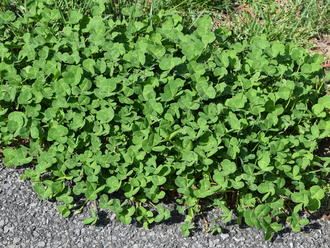White Clover (Trifolium repens L.)
↑Summary
A familiar plant of lawns and mowed grassy areas, white clover is a nitrogen-fixing legume native to Europe through central Asia, and has been introduced to many regions worldwide, including North America.
↑Range - Expand
| Legend | Color |
| Introduced | |
| Introduced or Not Present |
This tentative map is based on our own research. It may have limited data on Canada and/or Mexico, and there is some subjectivity in our assignment of plants as introduced vs. expanded. Read more in this blog post.
Although this plant occurs somewhere in each of these regions, it may only occur in a small part of some or all of them.
↑Habitat
Prefers full to partial sun and mesic conditions. Usually restricted to lawns and other regularly mowed areas, where it is common. Its low height makes it get outcompeted by other vegetation in areas that are not mowed regularly.
↑Control
Although introduced, this species is usually limited to lawns and other mowed areas around humans and as such there is little need to control it in most cases.
Some people attempt to control this species by applying selective herbicides that target all broadleaf plants, but this kills a wide variety of plants, including native plants, and decreases the total biodiversity and usually overall health of a lawn.
One way to reduce this plant's density in a lawn and sometimes eliminate it, however, is to raise the height of mowing. This species is low growing but also has high light needs, so raising the mowing height can lead it to get out-competed by grass and other vegetation.
Clover also thrives in nitrogen-poor environments, so leaving grass clippings on your lawn so as to cycle nutrients back into the system can limit its dominance. Some people fertilize their lawns, which often reduces the dominance of white clover, but this can result in nutrient pollution which can damage waterways downstream through eutrophication.
↑Uses
The main use of white clover is as a forage or animal feed; it is one of the most important forage crops. When grown as a crop, white clover serves a dual purpose of producing forage and fixing nitrogen. It is usually planted together with other forage plants, such as grasses. It works well in pastures because it tolerates close grazing by livestock.
White clover can also be used in gardens and agriculture as a companion planting, especially in poor soils, where it serves a dual role of soil cover and nitrogen fixation.
Although sometimes viewed as a weed, usually by people less knowlegeable about ecology who try to eliminate all broadleaf plants from lawns, white clover can be intentionally added to lawns and grass mixes, as it provides a natural nitrogen source. Such usage is particularly suited to sites with poor soils, although it is not able to thrive on the driest sites, and some other legumes can perform better in these situations.
↑Related Plants
There are several other Trifolium species overlapping with this one in most of North America. The native species are mostly rare with very limited distributions, but some of the other introduced species are more common.
Of these, red clover (Trifolium pratense) is most common; it has pink flowers, larger leaves, and a more upright growth habit.
↑Notes
White clover is the plant best-known for "four leaf clovers", widely thought to be lucky. However, the phenomenon of a normally trifoliate plant rarely having four or more leaflets occurs in most trifoliate species.
The focus on examples of this particular species having four leaflets may be due to the fact that it is so widespread, and occurs in lawns where it is easily visible, especially to children playing in the grass.
The occurence of four-leaf clovers (or even more rarely, plants with five or more leaflets) is probably influenced by both genetic and environmental factors. (source)
↑Links & External Resources
• White Clover | Fire Effects Information System (FEIS) (About This Site)
• Trifolium repens (White Clover) | Illinois Wildflowers (About This Site)
• Trifolium repens (White Clover) | USDA PLANTS Database (About This Site)
• Trifolium repens | Go Botany (About This Site)
• Trifolium repens (White Clover) | Missouri Botanical Garden Plant Finder (About This Site)
• Trifolium repens | Biota of North America Project (BONAP) (About This Site)
• Trifolium repens | NatureServe Explorer (About This Site)
• Trifolium repens | Missouri Plants (About This Site)
• White Clover | Maryland Biodiversity Project (About This Site)
• Trifolium repens (White Clover) | Minnesota Wildflowers (About This Site)
• Trifolium repens L. (White Clover, Dutch Clover) | Digital Atlas of the Virginia Flora (About This Site)





